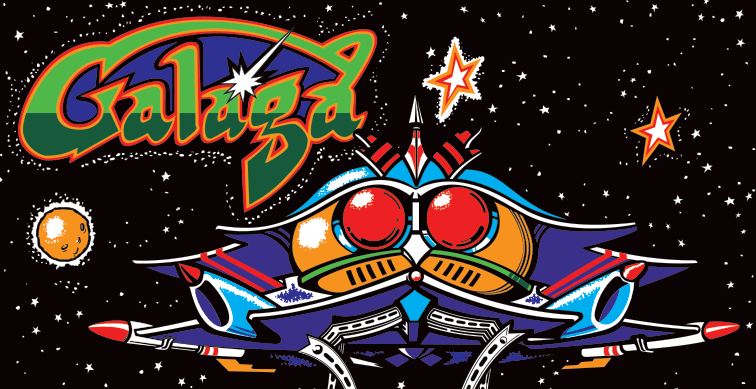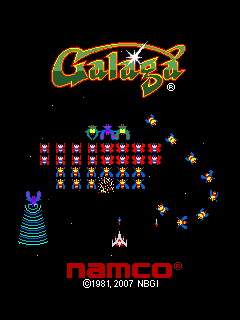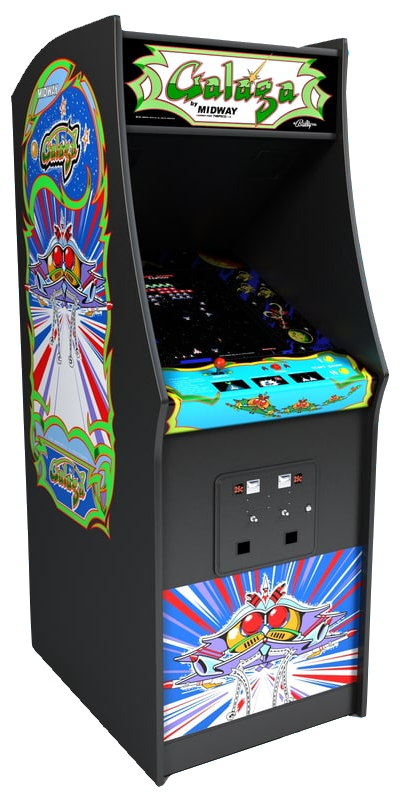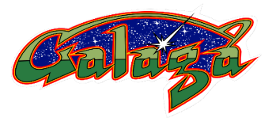Galaga

Galaga is a Japanese arcade game developed and published by Namco Japan and by Midway in North America in 1981. It is the sequel to 1979's Galaxian. The gameplay of Galaga puts the player in control of a spacecraft which is situated at the bottom of the screen, with enemy aliens arriving in formation at the beginning of a stage, either trying to destroy, collide with, or capture the spaceship, with the player progressing every time alien forces are vanquished.
Galaga is one of the most commercially and critically successful games from the golden age of arcade video games. The arcade version of it has been ported to many consoles, and it has had several sequels. In 2011, the game celebrated its 30th anniversary with the release of Galaga 30th Collection for iOS.
 The objective of Galaga is to score as many points as possible by destroying insect-like enemies. The player controls a starfighter that can move left and right along the bottom of the playfield. Enemies swarm in groups in a formation near the top of the screen, and then begin flying down toward the player, firing bullets at and attempting to crash into them. In later stages, some enemies even break from an entering group in a frantic attempt to crash into the player. The game ends when the player's last fighter is lost by colliding with an enemy, being hit by an enemy shot, or being captured.
The objective of Galaga is to score as many points as possible by destroying insect-like enemies. The player controls a starfighter that can move left and right along the bottom of the playfield. Enemies swarm in groups in a formation near the top of the screen, and then begin flying down toward the player, firing bullets at and attempting to crash into them. In later stages, some enemies even break from an entering group in a frantic attempt to crash into the player. The game ends when the player's last fighter is lost by colliding with an enemy, being hit by an enemy shot, or being captured.
Galaga introduces new features from its predecessor, Galaxian. Among these are the ability for two player shots to exist on-screen at once rather than one, a "hit/miss ratio" statistic at the end of the game, and a bonus "Challenging Stage" that occurs at Stage 3 and every fourth stage thereafter, in which a series of 40 enemies fly onto and off the screen, 8 at a time, and moving in set patterns without firing at the player's ship or trying to crash into it. When you destroy a group of enemies, you are awarded 1K-3K pts. These stages award a 10K-point bonus if the player manages to destroy every enemy, but otherwise 100 bonus points for every enemy destroyed. Another feature in the game is for enemies to randomly transform and organize into a certain formation, which awards the player bonus points if they manage to successfully destroy all three (1K to 3K points), from levels 4 on, and repeating every 256 levels.
 Another gameplay feature new to Galaga is the ability for enemies to capture the player's fighter. While the player is in control of just one fighter, a "boss" Galaga (which takes two hits to kill, the first hit will turn it purple) will periodically attempt to capture the fighter using a tractor beam. If successful, the fighter joins the enemy formation as a satellite to the boss Galaga which captured it. The captive fighter becomes an enemy, turns red, and likewise, it can be shot and destroyed, awarding the player 1K points on its destruction. The player can still fire while being captured up to the point their ship "touches" the captor, which could be considered an opportunity to shoot the captor down before it can manage to successfully capture the player. Captive fighters can be freed by destroying the boss Galaga towing it while it is attacking. The freed fighter will then combine with the player's fighter who freed them and form a Dual Fighter, offering doubled firepower but with the disadvantage of a target twice as large. If the player destroys the captor while it is still in formation, the captured fighter will not be rescued, and will instead fly away after a diving run (assuming the player does not destroy it) to appear in the next stage as a satellite for another boss Galaga where it can again be rescued. A very small section in the middle of the Dual Fighter is immune to enemy fire.
Another gameplay feature new to Galaga is the ability for enemies to capture the player's fighter. While the player is in control of just one fighter, a "boss" Galaga (which takes two hits to kill, the first hit will turn it purple) will periodically attempt to capture the fighter using a tractor beam. If successful, the fighter joins the enemy formation as a satellite to the boss Galaga which captured it. The captive fighter becomes an enemy, turns red, and likewise, it can be shot and destroyed, awarding the player 1K points on its destruction. The player can still fire while being captured up to the point their ship "touches" the captor, which could be considered an opportunity to shoot the captor down before it can manage to successfully capture the player. Captive fighters can be freed by destroying the boss Galaga towing it while it is attacking. The freed fighter will then combine with the player's fighter who freed them and form a Dual Fighter, offering doubled firepower but with the disadvantage of a target twice as large. If the player destroys the captor while it is still in formation, the captured fighter will not be rescued, and will instead fly away after a diving run (assuming the player does not destroy it) to appear in the next stage as a satellite for another boss Galaga where it can again be rescued. A very small section in the middle of the Dual Fighter is immune to enemy fire.
In 1995, Namco re-released Galaga along with an enhanced remake titled Galaga Arrangement, which features a number of graphical enhancements and gameplay differences from the original. Galaga Arrangement has subsequently been published as part of the Namco Museum compilation on several home video game consoles. Another remake, Galaga: Destination Earth, was released in 1998 for Windows, the PlayStation, and the Game Boy Color.
A Galaga Remix game was part of the 2007 Wii compilation Namco Museum Remix and its 2010 follow-up compilation, Namco Museum Megamix, but its gameplay completely unlike that of the original the Wii Remote is used as a gun, and players must "protect Pac-Man as he rolls through space, and quickly shoot down invading forces before they attack him." Galaga, along with Galaxian, Gaplus, and Galaga '88, was "redesigned and modernized" for an iPhone app compilation called the Galaga 30th Collection, released in commemoration of the event by Namco Bandai. A free-to-play mobile Galaga game based on the anime and manga Space Dandy, was announced under the name Space Galaga.
